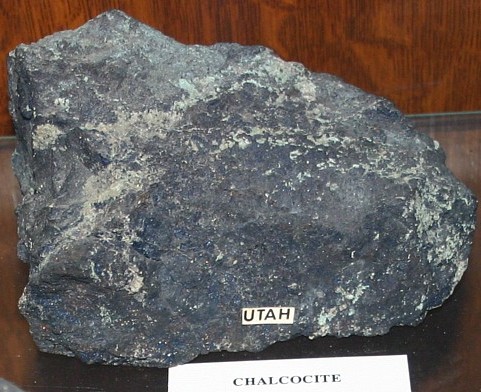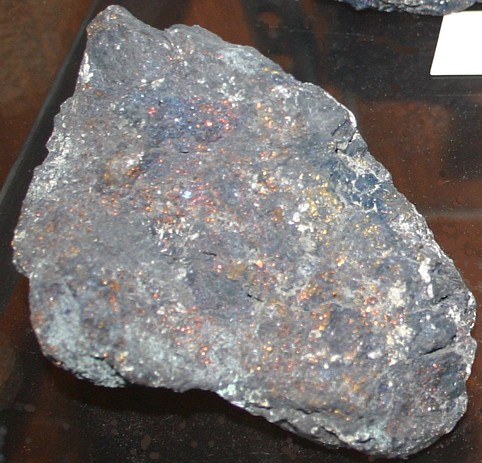|
.
Chalcocite
Mineral Facts:
Chemical Formula: Cu2S
Cuprous sulfide, Cu2S =
sulfur 20.2%, copper 79.8%. Also known as
Copper Glance.
Colors:
Shining lead-gray when fresh,
tarnishing on exposure to dull black. Streak grayish black.
Hardness:
2.5 to 3
Density:
5.5 to 5.8
Cleavage:
The cleavage of
chalcocite is indistinct, its fracture is conchoidal.
Crystallography:
Orthorhombic
Luster:.
Metallic gray, but tarnishes quickly in air, taking
on an earthy appearance.
Optics: (Refractive Index) = Opaque
|
 |
|
|
Composition and
Associated Minerals:
Occurs as a
mineral of secondary origin in the enriched zone of copper veins associated
with bornite, chalcopyrite, enargite, malachite, pyrite, etc.
Identification
and Diagnostics
Chalcocite is
recognized by its color and crystallization. It is also recognized by its
massive structure, its high specific gravity, its color, softness and black
streak. Massive varieties are distinguished from argentite by greater
brittleness and the reaction for copper; and from bornite by the fact that
it is not magnetic after roasting.
Occurrence,
Localities and Origins:
The mineral
is a common product of the alteration of other copper compounds in the zone
of secondary enrichment of sulphide veins. It is therefore present at most
localities of copper minerals. One of the best known occurrences is Butte,
Mont. It also occurs at the Canton Mine in Georgia and in the Polk Co.
copper mines in Tennessee. Pseudomorphs after many other copper minerals are
common. Fine crystals of chalcocite occur in veins and beds at Redruth and
at other places in Cornwall, England; at Bristol in Connecticut, and at
Joachimthal in Bohemia. The massive variety is known at many places. In the
United States it occurs in red sandstone at Cheshire in Connecticut. It is
found also in large quantities near Butte City in Montana, and in Washoe and
other counties in Nevada, and indeed in the veins of most copper producing
mines. In Canada it is present with chalcopyrite and bornite at Acton,
Quebec, and at several places in Ontario north of Lake Superior.
.Return
to
Mineral Collectors Information Page |
 |
|


